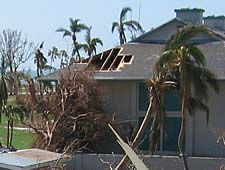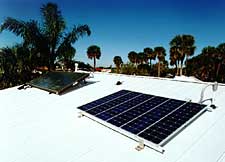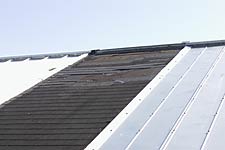
|
|
October 2004 |
Energy-Efficient
Choices Can Provide Post-Hurricane Benefits:
With the state of Florida slammed by a record four hurricanes in the summer of 2004, many homes need re-roofing and repair. Following the recent disasters, it is very difficult to obtain the services of a roofer. Meanwhile, many Floridians are without power and physically suffering without air conditioning. Further, many homes sustained floor water damage– particularly in carpeted or wood floor areas. While coping with the aftermath of the hurricanes is difficult, Florida Solar Energy Center® (FSEC®) buildings research offers practical methods when making repairs. FSEC research findings can be applied to make repaired homes more energy efficient and comfortable in the event of power outages and more resilient when faced by future storms. Cool Roofs If you have to re-roof, choosing the right roof can result in a cooler home, reducing the energy used when you air condition and making conditions more comfortable when power is not available.
FSEC research spanning the last decade has clearly shown that a white reflective tile or a white metal roof can reduce space cooling by 20% or more. More recent testing has shown that unfinished Galvalume roofs– which look like brushed aluminum– can provide about half that cooling benefit. Light colored tile roofs can provide similar improvements in performance. Tests performed by FSEC show the temperature in attics covered by dark shingle roofs can reach as high as 140 degrees on summer days. Meanwhile, a white metal or white tile roof never gets much hotter than the outside temperature, with light colored tile or metal registering somewhere between. Though metal roofs can cost twice as much as shingle roofs, and tile roofs three times as much, they last at least two to three times as long and keep the home much cooler. That means average savings of more than $100 per year in reduced air conditioning, as well as a much cooler home interior in the event that no air conditioning is available– such as the current experience of many Florida homeowners without power in the wake of the hurricanes of 2004. Even if you must go with shingles when re-roofing (many roofs cannot support tiles without physical strengthening), it is best to choose the lightest-colored shingle roof and consider installing a foil radiant barrier on the underside of the roof decking. Testing performed for the Florida Power and Light Company showed that simply choosing white shingles would reduce space cooling by 4% and choosing lighter colored shingles with a radiant barrier should cut cooling costs by twice that or more. All these options will provide slightly better comfort on the interior when air conditioning is not available. A standard, 2,500-square-foot roof will cost $5,000 to $6,000 to replace with shingles, $8,000 to $12,000 with metal, and about $15,000 with concrete barrel tile. Many homes cannot support the weight of a tile roof without extensive work beforehand, making metal roofs such as Galvalume the more practical choice for many. A Stronger, More Forgiving Roof When houses are exposed to hurricane forces, roofs are most susceptible to damage, followed by walls and openings, and then foundations. Data collected by HUD studies after major hurricanes show clearly that roofs are damaged more often than any other building component. Water penetration was a major problem whenever roofing material was removed by wind action. For steep roof systems, many roofing failures occurred at the ridge or gable ends where wind-induced forces were the highest. Gable ends were consistently found to increase the chances of roof failure in a number of forensic tests after hurricanes.
The most common roofing systems to fail during hurricanes are typically the lower-cost shingle roofs–particularly those applied with staples, which are now forbidden by current Florida building codes. Properly attached tile and metal roofs typically have done better in such storms as evidenced in numerous post-storm studies done by U.S. HUD after Hurricanes Andrew, Hugo and Iniki in the 1990s. However, construction quality matters with all roofing systems. Properly installed hurricane straps, nails and screws are a must. Tile roofs should be installed with nails or screws rather than mortar-set which is more prone to failure. While tile and metal have done better after the storms, a properly attached shingle roof with high-quality architectural grade shingles should do well. In any case, home owners should obtain multiple bids and deal only with licensed, reputable contractors in making roof repairs. After the storm, this is exceedingly difficult, however, as many homeowners with leaking roofs are looking for immediate solutions, and that demands improvised fixes-such as tarpaulins. Unfortunately, just as shingle roofs tend to have the shortest life expectancy in Florida’s difficult climate (15-20 years), they also often fail when exposed to severe winds, leaving many homeowners with shingle roofs looking for roofing help at the same time. In spite of the many benefits of the lighter color tile or metal roofs, many homeowners still go with the shingles. They’re cheaper to install, and they’re often chosen in darker colors for aesthetic reasons. Wind-resistant shingles are available, although they are more expensive. Generally, three-tab self-sealing shingles with a six-nail application pattern should be preferred. However, even with shingles you can choose lighter colored shingles at no incremental cost. Also, adding good ridge vents to a roofing system is a smart idea. The HUD post-hurricane research found that effective ridge ventilation was important in preventing sheathing uplift during hurricanes. Finally, if you install another shingle roof and have good attic ventilation, you ought to consider adding an attic radiant barrier that will help abate attic heat gain. Check out the Florida Solar Energy Center’s web site (http://www.fsec.ucf.edu) for detailed information on radiant barrier installation. Thus, a key advantage is to install a roofing system with greater longevity and resistance to storm damage. Tile or metal roofs typically have at least twice the life expectancy of shingle roofs and, if properly installed, can resist storms long into their service life. Indeed, it is possible to see many metal roofs installed in central Florida in the early 1900s that are still providing reliable service. Some tile roofs in South Florida are still in use though they were installed in the 1950s. The key point is to choose a stoutly-installed cooler roofing system (e.g. light colored tile or metal, properly adhered so that your home will run cooler, you will be less likely to suffer storm damage, and you will enjoy year-round savings on air conditioning. Based on the HUD research, the following are other issues to consider in making your roof stronger:
Most Floridians know that using hurricane shutters for windows is an important measure, but most have not considered how some systems such as louvered-Bahama shutters or awning shutters can provide shading for windows when not used to protect from storms. Such shading devices can also be deployed more rapidly and with less nuisance than stored plywood or storm panels. Not only will proper window shading reduce air conditioning, but it will also improve comfort when air conditioning is not available. Finally, some of the newer impact-resistant glass systems come with double-strength laminated glass with solar control properties which can cut down on heat transmission– a desirable characteristic nearly year round in Florida’s climate. It is also useful to improve the anchorage of windows to openings that are old or in poor repair– particularly for a large expanse of glass such as sliding glass doors. Also, garage doors—particularly double-wide garage doors—can be strengthened to improve storm resistance.
With the recent hurricanes, many homeowners have suffered water damage with soaked carpets, and without power to dry them. Many carpets have been ruined, and there is the greater threat of mold and mildew. Back during the 1960s, prior to the advent of widespread air conditioning and at a time when hurricanes in Florida were more prevalent, many Florida homes had tiled or terrazzo floors. Not surprisingly, a tiled or terrazzo floor is much more forgiving relative to water damage. Clean up is simple. There are also no carpets to create a potentially devastating mold problem. Perhaps just as important, FSEC research has shown that tiled floors feel cooler due to contact with the cooler ground underneath (the deep ground temperature in any location is equal to the average annual air temperature; eg. 72°F in Orlando). This free cooling is worth up to half a ton of air conditioning during early summer. And it can be a godsend when there is no air conditioning after a hurricane. Even more importantly, research, including that by Subrato Chandra at FSEC, has shown that carpeted floors can provide an excellent breeding ground for dust mites in Florida homes– a well known source of allergens for many people. All these factors suggest that replacing much of your moisture-damaged carpeted floors with tile will provide some help with cooling, comfort and maintaining a more allergy-free home. Confine carpet to bedrooms only or consider the use of throw rugs. Although many homeowners will be interested in accomplishing the repairs and replacements to their homes as soon as possible, they would do well to consider the long-term benefits of making energy-efficient choices as they make those repairs.
Selected References S. Chandra and D. Beal, 2001, “Preventing House Dust Mite Allergens in New Housing,” Presented at the Indoor Air Quality 2001: Moisture, Microbes, and Health Effects Conference, sponsored by the American Society of Heating, Refrigerating, and Air conditioning Engineers, Inc., San Francisco, California, November 4-7 2001. R. A. Cook, 1991. "Lessons Learned by a Roof Consultant." Hurricane Hugo One Year Later, Benjamin A. Sill and Peter R. Sparks, Eds. NY: American Society of Civil Engineers. R.A. Cook; Mehrdad Soltani; and Timothy A.Reinhold. 1994. "Lessons Learned from the Hurricanes of 1992." In Hurricanes of 1992, Ronald A. Cook and Mehrdad Soltani, Eds. New York: American Society of Civil Engineers. U.S. Department of Housing and Urban Development (HUD), 1993. Assessment of Damage to Single-Family Homes Caused by Hurricanes Andrew and Iniki. Office of Policy Development and Research, Washington, D.C. R. McCluney, 1981. “Window Treatment for Energy Conservation,” Florida Solar Energy Center, Energy Note, April 1981. (FSEC-EN-4) B.R. Manning and G. G. Nichols. 1991. "Hugo Lessons Learned."
Hurricane Hugo One Year Later, Benjamin A. Sill and Peter
R. Sparks, Eds. NY: American Society of Civil Engineers. D. Parker, J. Sonne and J. Sherwin, Flexible Roofing Facility: 2002 Summer Test Results, Prepared for: U.S. Department of Energy Building Technologies Program, July 2003 D. Parker and J. Sherwin, 1998. "Comparative Summer Attic
Thermal Performance of Six Roof Constructions," ASHRAE
Transactions, Vol. 108, Pt. 2 , FSEC-PF-338-98, Florida
Solar Energy Center, Cocoa, FL.
|



